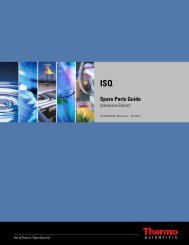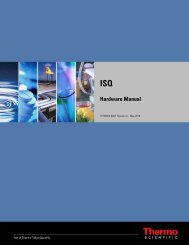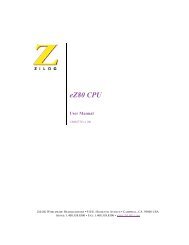ISQ User Guide - Write Frame of Mind
ISQ User Guide - Write Frame of Mind
ISQ User Guide - Write Frame of Mind
Create successful ePaper yourself
Turn your PDF publications into a flip-book with our unique Google optimized e-Paper software.
4 Creating a Method<br />
d. Click the Left Carrier or Right Carrier tab. The gas flow and the oven temperature<br />
work together to determine how well the analytes are separated and how long the<br />
analysis will take. You can select constant pressure or constant flow. If you use<br />
constant pressure, as the column is heated in the oven, the flow rate will fall because<br />
the hotter column is more resistant to carrier gas flow. If you use constant flow, the<br />
carrier gas pressure will increase as the column temperature increases to keep the flow<br />
constant. Constant flow is more common. Typical flow rates are 1-3 mL/min. The<br />
pressure depends on the column length and internal dimensions, so there is not a<br />
typical value. Because the outlet <strong>of</strong> the column is in the <strong>ISQ</strong>, which is under vacuum,<br />
the vacuum compensation should be on.<br />
The flow can also be operated in programmed flow or programmed pressure modes.<br />
In these modes, you may have up to three flow rates or pressures to use during an<br />
analytical run. This is not commonly used, but may be necessary if you have a<br />
particularly challenging separation.<br />
In an effort to reduce the amount <strong>of</strong> carrier gas used, you can activate the Gas Saver<br />
mode. When used, the split flow will be reduced to the gas saver flow after the gas<br />
saver time. It is not recommended to use a flow <strong>of</strong> less than 20 mL/min because<br />
contaminants can build up in the injector, column, and <strong>ISQ</strong>, which can affect the<br />
system performance.<br />
e. Click the Run Table tab to configure how to control external valves and devices.<br />
Consult the appropriate documentation for more detailed information.<br />
44 <strong>ISQ</strong> <strong>User</strong> <strong>Guide</strong> Thermo Scientific






